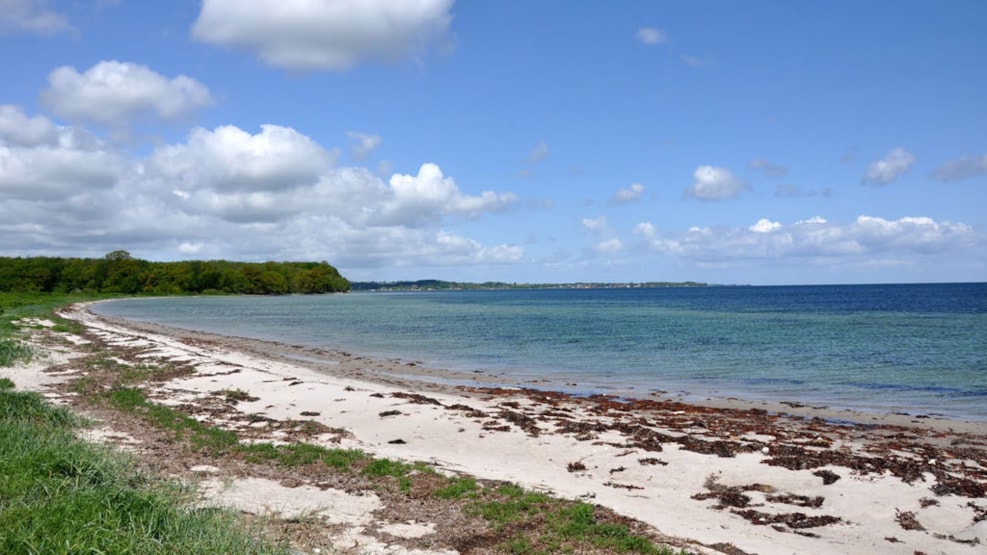
Thurø Smørmosen
During the summer, Smørmosen is a popular destination for both locals and tourists. Here, you'll find a lovely beach and mini golf.
Visit Smørmosen
Smørmosen is located on the east side of Thurø, just a 15-minute drive from Svendborg. The beach is sheltered by Smørmose Forest and is easily accessible, thanks to an asphalt road leading almost all the way down to the beach, ending in a parking lot. However, during the summer, it's essential to be quick as parking spaces are in high demand.
If you choose to walk to the left (north) along the beach from the parking lot, you'll soon reach the southern end of the Smørmose Cliff, which is 510 meters long and up to 12 meters high. A longer stretch in the middle with landslides and shrubbery divides the cliff into a southern and a northern half.
What to experience at Smørmosen
In addition to the beach, you also have the opportunity to play mini-golf. If you're up for a walk, you can stroll along the beach to Thurø Oyster Forest and Reef.
Geological perspectives at Smørmosen
For the best geological views, it's recommended to visit the site in the winter months when storms and high tides create fresh cuts in the geological layers and remove landslide materials. This is also the time of year when the most stones are typically found on the beach, as much of the sand has been washed away by the waves. Various erratic blocks (stones that can be traced to specific locations) from both Central and Southern Sweden, as well as from the Baltic Sea region, can be found.
In the southern half of the cliff, at the bottom, gray till clay was deposited by the 'Northeast Ice' around 23-21,000 years ago during the last ice age, the Weichsel. Above this layer is brownish till clay from one of the last advances of the Weichsel, possibly from the part of the Baltic Sea Ice Stream called the 'Great Belt Glacier' (18-17,000 years ago). This till deposit also forms the surface layer on the till plain and thus on most of Thurø. In some places, red streaks and bands can be seen in the upper till clay, resulting from crushed and eroded red sandstone from the Cambrian period (541-485 million years ago).
In the northern and most exciting half of the cliff, the stratigraphy starts at the bottom with two layers of blue-gray till clay. Both layers may originate from the younger part of the 'third-to-last ice age,' the Elster ice age (480-424,000 years ago). The lower of these two layers is also visible at Thurø Oyster Forest.
In the area that is now the current campsite, there was a narrow sound across Thurø after the formation of the Archipelago, dividing the island into two parallel islands. Later, the sound became a depression cut off from the sea and filled with various lake and marsh deposits - the area we now know as Smørmosen.
The nature of the beach in front of the cliffs varies with the changing seasons, but in the winter months, it is often covered with stones washed out of the till clay layers by the sea over time.
Smørmosen is part of the South Funen Archipelago Geopark
In 2018, Svendborg, Faaborg-Midtfyn, Langeland, and Ærø decided to establish the South Funen Archipelago Geopark with the aim of being designated as a UNESCO Global Geopark. The purpose of the geopark is to create and preserve an area that accommodates both humans and nature.
A UNESCO Global Geopark aims to showcase the geology, nature, and cultural history of an area, conveying a message that humans are part of life on Earth. It emphasizes our dependence on the Earth's resources, our vulnerability to climate change, and our responsibility for sustainable development.
The South Funen Archipelago Geopark tells the story of a dramatic sea-level rise in Southern Funen and the islands. This rise shaped a unique nature that, over the last 10,000 years, has laid the groundwork for the area's existence and cultural identity. It narrates how the landscape and archipelago continue to evolve, defining how we, as humans, live today. Moreover, the South Funen Archipelago Geopark is about understanding how, through sustainable development, we can continue to protect our special geological, biological, and cultural heritage.